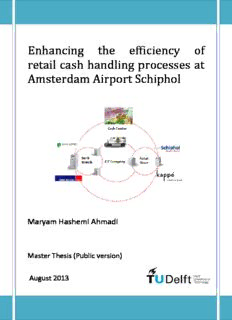
Enhancing the efficiency of retail cash handling processes at Amsterdam Airport Schiphol PDF
Preview Enhancing the efficiency of retail cash handling processes at Amsterdam Airport Schiphol
Enhancing the efficiency of retail cash handling processes at Amsterdam Airport Schiphol Maryam Hashemi Ahmadi Master Thesis (Public version) August 2013 I I Faculty of Technology, Policy and Management (TPM) Jaffalaan 5 2628 BX Delft The Netherlands www.tbm.tudelft.nl Schiphol Airport Retail B.V. Snipweg 7 Snipweg 7 1118 DN Schiphol The Netherlands Kappe' International B.V. Postbus 3065 2130 KB Hoofddorp The Netherlands Master: Management of Technology Title: Enhancing the efficiency of retail cash handling processes at Amsterdam Airport Schiphol Author: M. Hashemi Ahmadi Student Number: 4179927 August 2013 Date: Graduation Committee: Chair: Prof. dr. L. Tavasszy (TPM – TLO) First Supervisor: Drs. R. van Duin (TPM – TLO) Second Supervisor: Dr. H. Warmelink (TPM-POLG) Third supervisor: Dr. Ir. S. Meijer (TPM-POLG) External supervisor: P.J. Rozenberg (Schiphol Airport Retail) II III Abstract During the recent years, electronic payment methods have become more customary and in cases more preferable. Nevertheless, cash remains a popular form of payment due, inter alia, to its ubiquity. Large use of cash is associated with security issues, investment costs, logistics costs of transport and handling cash, personnel costs, and the like. To deal with these issues, many retailers have, to different extents, outsourced cash handling services to CiTI companies. Kappe’ and Schiphol Airport Retail (SAR) are two retail groups functioning at a number of locations in Amsterdam Airport Schiphol. They currently outsource part of their cash handling services to ABN-AMRO and GWK- Travelex. This results in a further increase in costs incurred by Kappe’ and SAR. Consequently, enhancing the efficiency of money flow is of significant importance to both corporations. The aim of this research is to develop cash handling processes which can bring about a more efficiency. This is done firstly by conducting a literature review on the reasons behind large costs of cash handling for retailers. Then the current processes of cash handling at Kappe' and SAR are studied to explore their deficiencies. After that, alternatives (e.g. automation, joint cash office, clustering) which can bring about a more efficient cash handling process are proposed and assessed on criteria of interest to the problem owners (Kappe' and SAR). The implementation chapter is done for the selected alternative. In the next stage, the prudence of the selected processes is re-evaluated by using a multi-criteria analysis methodology and also based on the trends in customers’ use of cash in payments. Finally, given the findings of the research, recommendations are provided for possibilities of further improvement in cash handling processes. Key words: Retailers’ costs of payment, Efficient cash handling processes, Activity-Based Costing, Cash-in-Transit Company, Cash recycling, and Multi-Criteria Decision Making I Cash in Transit IV V Preface The report at hand is the result of my graduation research project at Schiphol Airport Retail (SAR) and Kappe' during the period between February 2013 and July 2013. With this graduation thesis, I conclude my study in MSc. Management of Technology at Delft University of Technology, the Netherlands. For the completion of this research, I am indebted to the priceless guidance of my first supervisor Drs. Ron van Duin. I am as well grateful to Prof. Lorant Tavasszy and Dr. Sebastiaan Meijer for their valuable feedback. I would also like to express my sincere gratitude to Ms. Cindy Groothuizen, Mr. Casper Vos, Mr. Peter-Jan Rozenberg, and Mr. Jacques Parson from SAR and Kappe' for their support and constructive comments. I shall thank Baris Ozkale, my fellow intern at Schiphol, for having been notably cooperative. I would also like to express my appreciation to Dr. Jafar Rezaei for his assistance in clarifying the non-familiar aspects of the methodologies, and Mr. Yashar Araghi for his help with the complications of the project. Last but not least, I would like to take this opportunity to express my eternal gratitude to my mother, father, uncle and brother for their unconditional love and support throughout the years. I am also greatly thankful to my aunt, Zohreh, her lovely family, and my friends, Houriyeh, Nazpar, Shadi and Mahtab for all their help and kindness. Maryam Hashemi Ahmadi August 2013 VI VII Table of contents ABSTRACT IV PREFACE VI Table of contents VIII List of tables XII List of charts XIV List of figures XV Glossary XVI CHAPTER 1: INTRODUCTION 1.1.Research problem 2 1.1.1.Current procedure of cash handling 2 1.1.2.Problem formulation 3 1.2.Research objectives 4 1.3.Research scope 5 1.4.Research questions 5 1.5.Research methodology 7 1.6.Data collection 8 1.7.Research structure 8 Summation 10 CHAPTER 2:CASH PAYMENTS AND COSTS COMPONENTS IN CASH HANDLING PROCESSES 2.1. Popularity of cash 11 2.1.1. Popularity of cash among consumers 13 2.1.2. Acceptance of cash by retailers 13 2.2. Costs of cash payments 13 2.2.1. Consumers' costs of cash 14 2.2.2. Retailers' costs of cash 15 Summation 18 VIII CHAPTER 3:CURRENT CASH HANDLING PROCEDURES AT KAPPE’ AND SAR 1.1.Payment methods at Schiphol 21 1.2.Financial institutes at Schiphol 21 1.3.Map 21 1.4.Cash handling processes 22 1.4.1.Cash handling at Kappe's stores 22 1.4.1.1.Kappe's old system 23 1.4.1.2.Kappe's new system 26 1.4.2.Cash handling at SAR’s stores 29 Summation 33 CHAPTER 4:SOURCES OF COSTS IN CURRENT CASH HANDLING PROCEDURES AT KAPPE' AND SAR 4.1. Activity-Based Costing 35 4.1.1. Definition 35 4.1.2. Applications of ABC: motivation for choice of methodology 35 4.1.3. Stages of ABC 36 4.1.4. ABC for Kappe' 41 4.1.5. ABC for current system of SAR 41 4.2. Analysis of sources of costs 43 4.2.1. Sources of cost in Kappe's old system 43 4.2.2. Sources of cost in Kappe's new system 44 4.2.3. Sources of cost in SAR's current system 45 4.2.4. Comparison of current systems at Kappe' and SAR 46 4.3. Sensitivity analysis 46 Summation 48 CHAPTER 5:ASSESSMENT CRITERIA, AND BENCHMARKS 5.1. Stakeholder analysis 50 5.2. Assessment criteria 51 5.2.1. Criteria from the perspective of Kappe' and SAR 51 5.2.2. Employee requirements 53 5.2.3. Customer requirements 54 IX
Description: